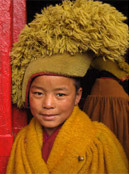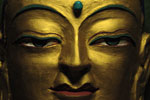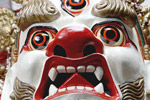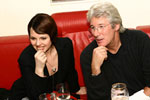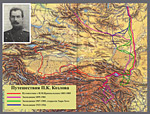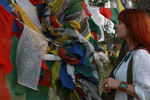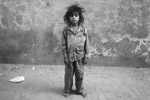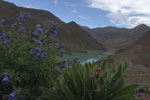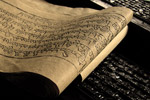Traditional Tibetan Buddhist psychology and psychotherapy
Interview with Dr. Pasang Y. Arya, Sylvie Beguin.
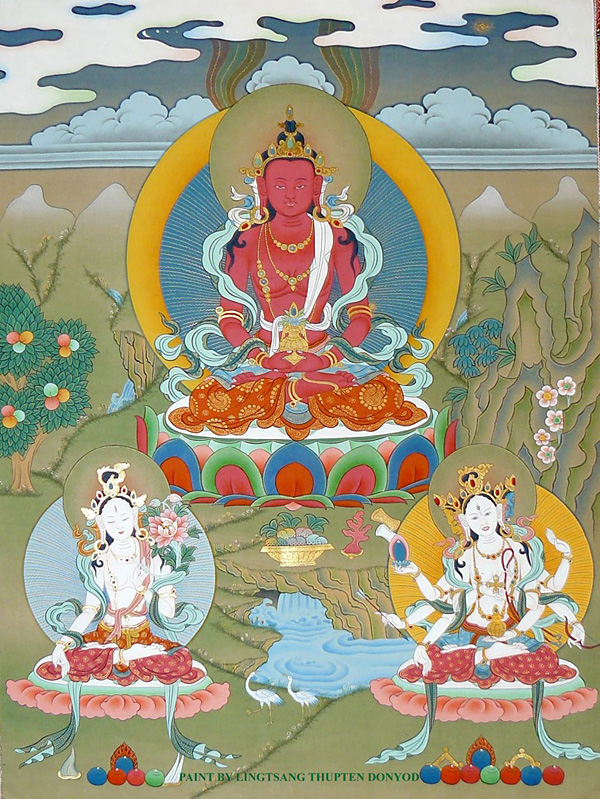
Three Long Life Deities: White Tara, Buddha Amitayus, Ushnishavidjaya.
Author: Thupten Donyod from Lingtsang
What is the lha?
“Lha” (bla) in Tibetan means ‘superior body‘, or ‘energy body‘. According to the Tibetan medicine and astrology concepts, between the physical body and the mind is the Lha body, which develops like a body copy, a shadow or reflection of the physical body. Therefore it is called subtle or energy body. It can hardly be seen by naked eye. The Lha body is very important to the health of the body/mind, as it always protects, nourishes and gives energy to the physical body, keeping it strong, stable and powerful. It gives psychological confidence, sense of ego and it plays a defensive role. The natural shape and form of the Lha body is exactly like that of the physical body and therefore they can be thought as dual bodies. When the subtle Lha body and the physical body are in correct position, it could bring harmony, the person feels well, has only few doubts and confusion, has a good concentration, a stable mind and a good immune system. If our physical body is healthy and in good condition, of course our mind and emotions are more stable and function well. But the modern stressful life, traumatic situations and many natural conditions can weaken the equilibrium between the physical body and the subtle Lha body, creating the conditions for a possible division, weakening, or loss of contact between the two bodies. This result of losing the Lha body is called: «lost Lha ». Lha can be damaged, become ill or leave the physical body, which could cause serious effects for the person.
- What does happen to the lha after the death ?
- After the death, Lha and consciousness separate. The consciousness continues its journey, drawn to the next reincarnation by its karma, whilst Lha stays on the earth, still bearing the person’s shape, until the physical body becomes fully decayed. Although Lha is an energy and reflection of the body, it also has a kind of pseudo-consciousness.
- Where does this pseudo-consciousness come from ?
- It is like a video film, if you save a voice or image, even when the person is not there anymore, the image remains. Lha is like that. During the life, body and mind, thinking power, emotions, sounds, all the knowledge and experience that the person has, have like a copy remaining with the Lha body and so, after death, the Lha body may act as before, visiting places, friends, family, work, fields,… and can sometimes even express itself, for instance through a medium voice or possession. But unlike the mind, Lha body has no reincarnation; that is the difference. Once the corpse is destroyed, the Lha is also completely destroyed.
In Tibetan medicine and tantra, there is a wind energy called Norlegyal, the last of the five minor body wind, which also remains in the body after the death until the body becomes completely decomposed. Then, I think Lha and Norlegyal are very much connected.
At the child conception, when the consciousness reincarnates and gets a new life, a new Lha also appears together with the physical body, like a shadow, a bit like the smell with fruits. When the child is born, Lha is born too. When the person develops, Lha also develops. And when we get older, our Lha also gets older.
- When a body is burned after the death, is the left material still a support for the lha?
- When the body is burned and becomes like ashes, it then has a different composition, and so the Lha has a very little chance to remain much longer. That is probably why Tibetans generally prefer the body cremation or sky burial.
In the Tibetan tradition, after the death, the body is often burnt and the bones collected. At the relatives’ request, a bone ritual ceremony may be performed to purify the bones, from which tsa-tsa (little statues or images of the Buddha) are then made and kept in a special place. It is a common practice. In that case, perhaps the attached Lha is purified or becomes positive, and won’t harm anyone.
The Lha ceremony is generally done for the sick person to recover the Lha, but it is also done for the healthy people to re-strengthen and re-stabilize it. For the dead, there is no Lha ceremony per say, but the bones ceremony which, I think, beside its religious concept, is also connected in a certain way to the Lha.
- Can one feel the lha body?
-
It is not easy, because most people don’t care about it and are even not aware of it at all, but I think that if one is hypersensitive and feels concerned about it, it is possible to perceive or see it.
- What is the connexion between lha and tsa-rlung practice?
-
The Tsa-rlung therapy is very much related with the Lha body energy. Actually, in the tsa-rlung practice, when we focus on the patient’s body with the eyes closed, and see the shape of the person, we actually look at the Lha body, and according to its condition, we can know what the person’s problem is.
- Is it possible to diagnose a lha problem by taking the pulse?
-
There is a special pulse, called ‘Lha pulse‘, which is taken at a different place than the usual disease pulse; the Lha pulse is taken on the ulnar artery. If this pulse beats smoothly and gently many times, for instance fifty or one hundred times without disturbance, it means that the Lha situation is good. If the Lha condition is bad, then on the ulnar artery, one can feel a special beating, disturbance or interruption. The Lha channel goes from the heart to the ring finger along the ulnar artery. From there, it goes out, fifteen, sixteen fingers and comes back, as said in Tibetan medicine and astrology. Lha comings and goings of fifteen, sixteen fingers distance from the physical body is a normal movement but remaining at that long distance is not common.
Sometimes, when a person is shocked, has an accident, is sad, depressed and has psychic problems, the Lha may go away quite longer, even long distance, and the contact between the two bodies may be lost, like radio and antenna. If the contact is lost, then the person begins to suffer, feel lonely, weak or he has a double personality. The symptoms of damage or loss of the Lha can be: depression, unhappiness, fear, insecurity, empty feelings, panic attacks, rising anxiety, difficulty to concentrate, nightmares, recurrent dreams of being naked, losing clothes or hair, or wearing ripped clothes, feelings of strangeness, paleness, illness without obvious causes…
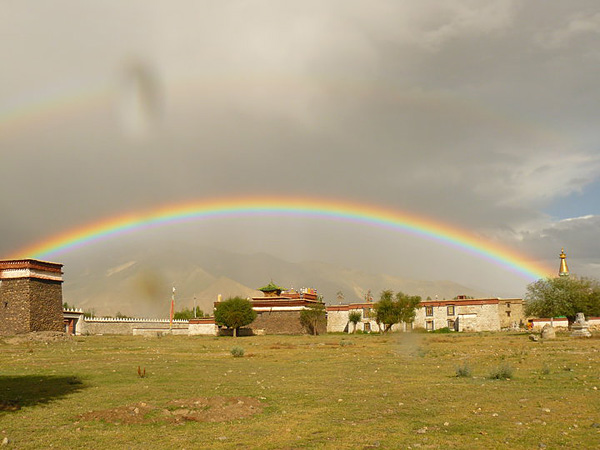
Samye Monastery in Tibet, 2007.
Photo: Nadia Bekrkengeym
- Sometimes it is said that a person’s lha has been stolen, how does it happen?
Can we live without the lha?
- Lha may be stolen by spirits, and generally more in spring and autumn. Body without Lha is like apple without smell and taste. It has no vital energy or power. Spirits hunt the Lha body, because they can use it as food.
Our body/mind is generally naturally very well protected by Tse, Le, and Sonam, which are our life span, karma, and fortune energies, the three pillars of life. But if one of these energies is weak, spirits can easily attack,- especially when joined with some unfavorable astrological energy cycles of the person or when the person is psychologically down – and take advantage on the situation. Spirits generally don’t have the power to attack the physical body, then instead, they attack the Lha body and take it away. And then the physical body begins to get some sicknesses. It is like a little baby who has lost his mother. Even if still alive, it lacks protection and energy source. If you discover the Lha loss early, then it can be taken back through the Lha ritual ceremony. But if you don’t discover its loss soon enough, then, depending on what had happened to it, even the Lha ceremony cannot bring the Lha back, then the patient’s life may slowly, slowly go to an end.
In Tibet, there is a Samye Monastery, which is one of oldest of all. It has a small spirit temple, the Samye Ugkhang, ‘the house of the breath‘, breath of the dead beings. It is a place where the Lha is brought when a person is going to die. Actually, the Lha is related with the breathing, as the connection between the physical body and the Lha body is done through the breath. When a person is very sick and in a terminal stage, then the spirits send the soul fetcher to take the sick person’s Lha. Without doubt they terrorize the Lha pseudo-soul but the dying person is not aware of it. They put it in a bag called ugkyel, which means ‘bag of the breath‘, and bring it to the Samye spirit temple.
When I was young, my master told me this story many times related with the subjects of medicine and astrology. It was always fascinating and also one of his favorite. He said that at that place, there is a particular smell, and also that during the night you can hear the sound of the spirits working, killing the Lhas to eat them, by cutting them with a knife on a large piece of wood, that has still to be changed every year by the Tibetan government.
- The spirits are inside the Samye monastery?
- This temple is inside the inner circle of the Samye Monastery but at around 400 meters distance from the main temple. Actually the spirits are the protectors of Samye. Guru Rimpoche (8th century) subdued them, and gave them the authority to have this power on Lhas. In the Tibetan legend, it is said that the dying people’s Lha are brought there to be killed, because if not, Lha remains and could act like spirit for a certain period before eventually disappearing. According to what my master said, the spirits are really still there. Incidentally, during the Chinese Cultural revolution, this temple suffered, but was not destroyed.
Anyway, some years ago, I got the chance to visit Tibet and of course I wanted to see that special place. Actually, I was a bit afraid and felt very emotional as I remembered all the stories told by my master, and also because of a book I’d read about Samye, that tells about that very clearly. So when I went there, I saw this special place. There is an old door with two holes (where spirit and breaths can pass) and two ugkyel, leather bags, hang on the sides of the door. I was a little bit scared but couldn’t restrain myself from looking through the holes. But inside, it was completely dark, I couldn’t see anything. Then I smelled, and the smell was very strange indeed. I didn’t smell much because there might be something full of bacteria! Anyway, I preferred not to stay too long!

The Lha ritual ceremony
Lha is very popular where the Tibetan culture has spread, like in Nepal, Buthan, Indian Himalayas, Tibet and the surrounding areas and generally people know well its ceremony and its benefit. The Lha ritual ceremony, Lhagug-tsegug, is an ancient Tibetan healing method that restores the energy balance between the physical body, the mind, and the Lha body. This healing ritual is very effective, and Tibetan people really love it.
The Lha ritual ceremony actually comes from the Bonpo tradition and has been practiced in Tibet probably for thousands of years. When Indian Buddhism came to Tibet, this ritual, due to its effectiveness, was integrated with Buddhism, and since then has been practiced by the Buddhist tantric practitioners, lamas, geshes or monks who perform tantric rituals and healing.
- If one suspects some problem with the lha, can something be done, apart from the lha ceremony?
- I think it is a bit difficult. If the Lha has gone through a long distance because of physical disease condition, one should try to cure the person of course. If the person recovers from the disease, maybe the Lha could come back closer. But if the person’s Lha has gone through a much longer distance, by shock and trauma, then it is difficult to bring it back, and one needs the ritual ceremony.
- How does the lha ceremony function ? What is the «mecanism»?
-
This complex ceremony works at material, spiritual and energy levels. During the ceremony, the patient is sitting in front of the ritual performer, who uses meditation, concentration, and mantra reciting. The ritual is performed through hymn and dialogue with the Lha stealer, then the patient’s name is called with a deep and profound voice, as the lha bears the same name as the person. Generally, some people are also sent to places where many people gather like cities or road crossings, big trees, fords, palaces, etc. These people also call the Lha’s name, with deep and profound sounds, asking it to “come back”. The Lha hears the call and if it is still possible, comes back and rejoins with the patient’s body. It is like when you call someone and that the person comes back home.
When the Lha is lost, the person feels a bit lost, but when the Lha comes back, then something changes in the deep psychic level and the concentration, self trust, confidence and feeling of being strong improve.
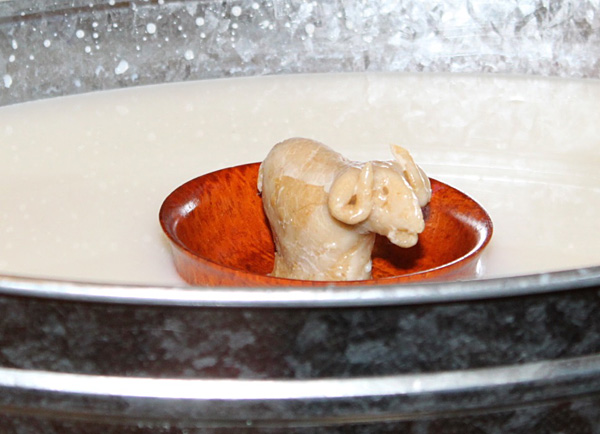
During the ritual, one important instrument also used is a copper container filled with water, inside which there is a wooden plate with a butter-made sheep head ornamented on the forehead by a turquoise. The ritual performer recites the mantra and, along with meditation concentration, turns the wooden plate in the center of the water. At the end of the mantra recitation and visualization, the plate circling slows down slowly. When it stops, if the sheep’s head is facing the patient, one considers that the Lha has come back. If not, it means that the Lha is strongly occupied by spirits or is gone very far away. So mantra recitation and meditation, as well as the wooden plate circling, are repeated again until it stops. Therefore sometimes it takes a long time for the sheep head to face the patient and one has to repeat the process several times. If one cannot succeed, then one says that the Lha cannot come back and that the patient is probably going to lose his strength of Lha.
So in the Lha ceremony ritual, it is never mentioned about a « mechanism » and how it works, but I think the symbolism is very important: The container may be a symbol of the brain, our head, like the skull filled by water, as the brain is related to water. The sheep head is the symbol of the consciousness, mind and brain, and also the symbol of the Lha, the second body. Lha is kept there, as the sheep is a special animal that sustains and stabilizes the Lha energy. Turquoise is the Lha stone, the house or seat for the Lha energy. The turning of the plate with the sheep is to remind the soul to come back, a bit like when we reinstall the CD disc in the computer. When the plate turning slowly slows down, and when the process has been successful and the sheep head faces the patient, it means that the subtle body has rejoined the physical body. At the end of the ritual, the turquoise is given to the patient and should be kept forever.
After the Lha ritual ceremony, one should receive the long life initiation to re-energize and prolong the life energy.
By
www.tibetanmedicine-edu.org
![]()
![]()
![]()
![]()
